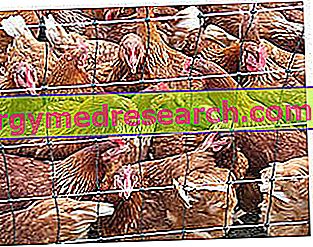What is Avian Influenza
Avian influenza is an infectious and contagious disease that affects domestic and wild birds, often causing serious illness and even the death of the animal. Type A influenza viruses responsible for avian influenza can also infect other animals and in some cases humans. Not by chance, t

The viruses that cause bird flu are therefore of different types. Their marked pathogenicity sets the stage for frequent mutations and recombination phenomena; in practice, avian influenza viruses have a tendency to mutate and exchange genetic traits to give rise to new viral subtypes.
In recent years, bird flu outbreaks have occurred in Asia, Africa and parts of Europe. The two main risks to human health arising from the disease are:
- direct infection, when the virus is transmitted by an infected bird to humans
- mutation or recombination of the virus in a highly contagious form for humans, more easily transmitted from person to person.
Premise
Circulating influenza viruses in animals represent a potential threat to human health. Humans can indeed get sick when infected with some viruses of animal origin, including avian influenza virus (with its subtypes H5N1, H9N2, H7N7, H7N2 and H7N3) and swine flu virus (subtypes H1N1 and H3N2) .
The main risk factor for human infection appears to be close contact with infected animals, live or dead, or with their feces and respiratory secretions.
Avian influenza in humans
Most avian influenza viruses do not cause disease in humans. However, some strains are zoonotic in the sense that they can infect humans and cause disease. The best known example is the H5N1 avian influenza virus, currently in circulation in poultry in some regions of Asia and Africa. Unlike seasonal human influenza, the H5N1 avian DOES NOT spread easily from person to person. Since the first human case in 1997, the H5N1 virus has killed almost 60% of infected people. Starting in 2011, this highly pathogenic virus is considered endemic in six countries (Bangladesh, China, Egypt, India, Indonesia and Vietnam); this means that the virus can commonly be found in poultry circulating in these countries. Sporadic outbreaks have also occurred in other countries.
In addition to H5N1, other subtypes of avian influenza viruses, including H7N7 and H9N2, have infected humans: some of these infections have been serious and have caused deaths, but for the most part they have been mild or even subclinical.
On April 1, 2013, the first known human cases of H7N9 avian influenza infection were reported in China. These have been associated with a serious, potentially fatal respiratory disease.
Avian influenza viruses have been isolated from more than 100 different species of wild birds around the world, including lime or aquatic birds (gulls, ducks, geese and swans). It is suspected that the infection may spread from these natural carriers to domestic poultry (chickens, turkeys, ducks) and other farm animals such as pigs, horses, dolphins and whales. Birds play an important role as a source of food and livelihoods in many countries affected by the avian influenza virus. For this reason, the WHO and other health sector bodies are working to identify and reduce risks to animal and public health in national contexts.
Symptoms and Complications
The signs and symptoms of avian influenza may vary. Disease onset occurs after a variable incubation period, 1 to 7 days from the time of infection. In most cases, the symptoms resemble those of conventional influenza, namely:
- Cough;
- Temperature;
- Sore throat;
- Muscle pains.
Some people also experience nausea, vomiting or diarrhea. In some cases, a mild eye infection (conjunctivitis) is the only expression of the disease. Symptoms may worsen and develop into a serious respiratory disease that can be fatal. In February 2005, researchers in Vietnam reported human cases of bird flu in which the virus had infected the brain and digestive tract.
Complications
People with bird flu can develop life-threatening complications, including:
- Pneumonia;
- Lung collapse;
- Respiratory failure;
- Renal dysfunction;
- Heart problems;
- Neurological changes.
Low pathogenic virus and highly pathogenic viruses
Avian influenza viruses (type A influenza viruses) belong to the Orthomyxovirus genus. Their surface antigens H (emagglutinin) and N (neuraminidase) may vary, giving rise to different viral phenotypes, referred to as H (n) N (n). The various strains are classified in low pathogenic virus (LPAI, Low Pathogenic Avian Influenza ) and in highly pathogenic virus (HPAI, Highly Pathogenic Avian Influenza ), based on viral structure, genetic criteria and specific molecular pathogenesis.
Avian influenza viruses are mostly low pathogenic, usually associated with a mild disease in poultry. In contrast, highly pathogenic viruses can cause serious illness and high mortality in birds.
LPAI viruses have the potential to turn into HPAI viruses. This behavior has been documented in some poultry outbreaks. Avian influenza viruses of the H5 and H7 subtypes, including H5N1, H7N3 and H7N9, have been associated with HPAI and the human infection caused by these viruses can range from mild manifestations (example: H7N3) to severe and fatal (H5N1 and H7N9).
Human disease caused by LPAI virus infection shows very mild flu-like symptoms at onset. Examples of LPAI viruses capable of infecting humans include H7N7, H9N2 and H7N2.
Causes and Contagion
Bird flu affects many wild migratory water birds and can spread to domestic poultry, such as chickens, turkeys, ducks and geese.
Bird flu affects mostly wild birds that usually do not get sick but act as a reservoir and can eliminate viruses through feces and respiratory secretions. As a result, they can be very contagious to domestic birds with which men come into contact with greater ease.
The disease is transmitted through contact with the faeces of an infected bird or with its secretions from the nose, mouth and eyes. The most common modes of transmission are oral-faecal, oro-nasal and conjunctival transmission. Open-air markets or farms, where eggs and birds are sold in conditions of overcrowding and precarious hygiene, they can be hotbeds of infection and spread the disease in larger communities. The infection can be contracted simply by touching the contaminated surfaces.
The avian influenza virus (H5N1) finds in the low temperatures the best conditions for its survival, managing to resist in the environment for long periods (over 30 days at 0 ° C), and for an indefinite time in frozen material. On the other hand, it is very sensitive to the action of heat (at least 70 ° C) developed during food cooking.
| Stability and resistance of the avian virus | |
| CONDITION | SURVIVAL TIME |
| at low temperature in faeces | about a week |
| at 4 ° C, in the water | almost a month |
| at 60 ° C, in the water | about 30 minutes |
| at 100 ° C, in the water | about 2 minutes |
| direct exposure to sunlight | about 40-48 hours |
| direct exposure to ultraviolet rays | it is immediately inactive |
| acid environment (ph 4.0) | survives |
| glycerine | survives about a year |
| organic solvents: chloroform, acetone, etc. | it is immediately inactive |
| common disinfectants, oxidizing agents, diluent acids, halogens (chloride, iodine), etc. | it is immediately inactive |
Infected birds can continue to release the virus into their feces and saliva for 10 days from infection. The virus can be inactivated immediately by UV rays and common disinfectants, and is heat sensitive. According to the Food and Drug Administration, bird flu is not transmitted by eating infected bird eggs or properly cooked poultry meat. The consumption of poultry meat is safe if the cooking method allows to reach an internal temperature of at least 74 ° C. The eggs must be cooked until the yolk and egg white are completely thickened.
Risk factors
The biggest risk factor for bird flu appears to be close contact with sick birds or surfaces contaminated with feathers, saliva or infected droppings. The meaning of "close contact" differs from culture to culture. Some people contracted the H5N1 virus while cleaning or spurning infected birds. In China, there have been reports of infection in live animal markets by inhalation of materials dispersed in the aerosol. It is also possible that some people have been infected following bathing in water contaminated with infected bird droppings. Only in a few cases, bird flu has been transmitted from one infected human to another by direct contact.
People of all ages can contract bird flu. If a susceptible individual or animal is infected simultaneously with the avian influenza virus and that of human influenza, gene recombination may occur. Even without exchanging genes, the H5N1 virus has the potential to mutate into a form that more easily infects humans, spreading rapidly around the world. When this happens pandemics are unleashed, which in the past have caused very high numbers of patients, hospitalizations and deaths. When this happens again, the health authorities may be able to avoid the pandemic: H5N1, for example, is sensitive to the latest anti-flu drugs and a vaccine has already been created and stored by the World Health Organization.
| People more exposed to the risk of bird flu |
|
Diagnosis
Avian flu is usually diagnosed through a swab that collects secretions from the nose or throat within the first few days of the disease, after the onset of symptoms. The sample is sent to a laboratory, where avian influenza viruses will be searched and identified using a molecular test or appropriate cultures. Depending on the type of investigation, the results may be available after a few hours or weeks. In late stages of the disease, it can be difficult to identify an avian influenza virus using these methods, but it is still possible to diagnose the infection by looking for evidence of the immune response against the viral agent. Imaging can be useful for assessing the condition of the lungs and establishing the correct diagnosis and the best treatment options.
Antiviral drugs
For the treatment (and prevention) of a human infection with avian influenza virus, the prescription of oseltamivir or zanamivir is currently recommended. In particular, available analyzes for H5N1 indicate that most viruses are sensitive to these two anti-influenza drugs, known as neuraminidase inhibitors. Oseltamivir and zanamivir shorten the symptoms by a couple of days and reduce further viral multiplication in the cells. However, drug-resistance episodes have been reported in some human cases of H5N1 avian influenza. These antiviral drugs must be taken within two days of the onset of symptoms, which can be logistically difficult worldwide, if there is a widespread epidemic. Studies conducted in the laboratory suggest that drugs approved to treat the human influenza virus (eg amantadine and rimantadine) should also act in cases of avian influenza infection, but further studies are needed to determine their effectiveness.
Prevention
Currently, the best way to prevent avian flu is to avoid potential sources of exposure to viruses. Most human infections have occurred following prolonged and direct contact with infected poultry or (more rarely) with sick patients.
The European Commission has adopted some measures with the aim of preventing the disease from spreading in the territory. These include the prohibition of importing poultry meat and similar from countries affected by the epidemic and the mandatory labeling of poultry carcasses, with indication of the initials and the identification number of the breeding farm of origin. People who work with poultry or who are exposed to avian influenza outbreaks are encouraged to follow the recommended biosafety standards and implement infection control practices; these include the use of appropriate personal protective equipment and care of hand hygiene.
Vaccine
To prevent infection, the Food and Drug Administration has approved a vaccine formulated against many of the H5N1 avian flu varieties. This vaccine is not available to the public, but it is ready and stored by the WHO which will distribute it if an H5N1 virus starts an avian flu pandemic. The purpose of any vaccination is to provide limited protection until another vaccine is designed against the specific form of the mutated virus (indicatively within three or four months).
Note. The seasonal flu vaccine does not offer protection against avian influenza, but may reduce the risk of co-infection of the human and avian influenza virus in the same individual.
Individuals traveling to Southeast Asia or any region with sporadic outbreaks of bird flu should follow the following recommendations:
- Avoid contact with domestic birds. If possible, avoid rural areas, small farms and outdoor markets.
- To wash hands. This is one of the easiest and best ways to prevent infections of all kinds.
- Use an alcohol-based disinfectant (at least 60%) to wash surfaces or dishes touched by patients or people with suspected flu.
- Do not consume raw or undercooked meat or eggs
- Influenza vaccine. Before leaving, it is useful to ask the doctor for a flu shot. It does not specifically protect against avian influenza, but may help reduce the risk of simultaneous infection with human influenza and avian viruses.
Poultry and eggs
Proper handling and cooking of poultry and eggs eliminates the risk of acquiring bird flu by eating these foods. Heat destroys avian viruses, so properly cooked poultry is not a threat to health. By implementing some practices during poultry handling and preparation, it is also possible to avoid the spread of Salmonella or other harmful bacteria that can infect food.
- Buy poultry guaranteed by origin and origin
- Avoid cross-contamination. Use hot water and soap to wash cutting boards, utensils and all surfaces that have come into contact with raw poultry. Wash your hands with soap and warm water for at least 20 seconds before and after handling raw poultry and eggs. Separate raw and cooked foods from the fridge.
- Cook the chicken thoroughly until the juices that come out are transparent and a minimum internal temperature of at least 74 ° C is reached.
- Avoid raw eggs. Egg shells are often contaminated with bird droppings, so foods containing raw or undercooked eggs should be avoided to prevent bird flu.



